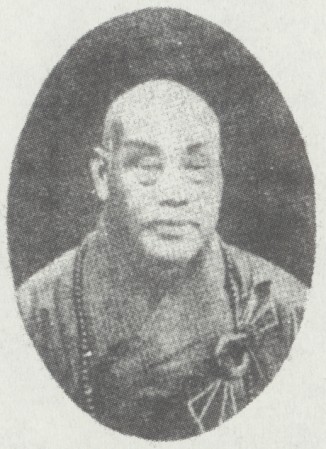Views
m |
m |
||
| Line 22: | Line 22: | ||
In July or August of [[1906]] (6 Guāngxù 光緒 32) he received dharma transmission from Cìyùn 慈運 of Níngbō's Qītǎ Bàoēn Temple 七塔[[報恩寺]], making him a 40th generation holder of the Línjì 臨濟 lineage. That same year, Yuányīng met Tàixū [[太虛]], who had come to Tāintóng Temple to receive the precepts. | In July or August of [[1906]] (6 Guāngxù 光緒 32) he received dharma transmission from Cìyùn 慈運 of Níngbō's Qītǎ Bàoēn Temple 七塔[[報恩寺]], making him a 40th generation holder of the Línjì 臨濟 lineage. That same year, Yuányīng met Tàixū [[太虛]], who had come to Tāintóng Temple to receive the precepts. | ||
| - | In [[1912]], Yuányīng accompanied Jìchán to Shànghǎi, where he joined the latter as part of the newly-formed Chinese General Buddhist Association [[ | + | In [[1912]], Yuányīng accompanied Jìchán to Shànghǎi, where he joined the latter as part of the newly-formed Chinese General Buddhist Association [[中華佛教總會]]. |
In November, [[1914]], Yuányīng traveled to South and Southeast Asia, visiting Buddhist communities in Sri Lanka, India, Burma, Malaysia, and Singapore. | In November, [[1914]], Yuányīng traveled to South and Southeast Asia, visiting Buddhist communities in Sri Lanka, India, Burma, Malaysia, and Singapore. | ||
Revision as of 00:47, 26 May 2009
Yuányīng 圓瑛 (1878-1953)
A towering figure of Republican Buddhism, and a critic of Tàixū's more radical suggestions for reform. He was president of the Chinese Buddhist Association from 1928 to 1937. He was the abbot of a number of important temples in the Jiāngnán 江南 region.
- Born June 20, 1878 (5/20 Guāngxù 光緒 4) in Gǔtián County 古田縣, Fújiàn 福建
- Died at 11p.m. on September 19, 1953 (Mínguó 民國 42) at Tiāntóng Temple 天童寺, Níngbō 寧波
- Lay Surname 姓: Wú 吳
- Name 名: Hēngchūn 亨春
- Style names 號: Tāoguāng 韜光
- Courtesy names 字: Yuányīng 圓瑛
- Dharma names 法名: Hóngwù 宏悟
Biography
Both his parents died when he was five. At the age of six he began education at a classical academy. He earned his Xiūcái 秀才 Degree at 16. At 8 he became seriously ill and vowed that if he were to recover, he would ordain as a monk. The following year he recovered and he took tonsured under Zēngxī shàngrén 增西上人 at Méifēng Temple 梅峰寺. He ordained under Miàolián 妙蓮 at Yǒngquán Temple 湧泉寺 in May of 1897 (4 Guāngxù 光緒 23).
He studied asceticism and ritual under Dáběn 達本, abbot of Chóngshèng Temple 崇聖寺 on Great Snowy Peak 大雪峰. He traveled, and studied Chán with Zhìkāi 治開, abbot of Chángzhōu's 常州 Tiānníng Temple 天寧寺. He stayed until April, 1903 (3 Guāngxù 光緒 29), at which point he went to Tiāntóng Temple 天童寺 in Níngbō 寧波. There he studied with Jìchán 寄禪.
In July or August of 1906 (6 Guāngxù 光緒 32) he received dharma transmission from Cìyùn 慈運 of Níngbō's Qītǎ Bàoēn Temple 七塔報恩寺, making him a 40th generation holder of the Línjì 臨濟 lineage. That same year, Yuányīng met Tàixū 太虛, who had come to Tāintóng Temple to receive the precepts.
In 1912, Yuányīng accompanied Jìchán to Shànghǎi, where he joined the latter as part of the newly-formed Chinese General Buddhist Association 中華佛教總會.
In November, 1914, Yuányīng traveled to South and Southeast Asia, visiting Buddhist communities in Sri Lanka, India, Burma, Malaysia, and Singapore.
He became abbot of Quánzhōu's 泉州 Kāiyuán Temple 開元寺 in March, 1924, and abbot of Chóngshèng Temple October, 1928. He became abbot of Bàoēn Temple in 1929, and abbot of Tāintóng Temple in February, 1930.
In 1928, Yuányīng was elected chairman of the Chinese Buddhist Association 中國佛教會, a position he held (with only brief interruption in 1931) until the Association ceased to function with the Second Sino-Japanese War. During the War, he helped organize a monastic defense force, composed of members of the Young Men's Buddhist Associations 佛教青年會 of the Jiāngnán region.
In 1938, he once again traveled to Southeast Asia, returning to Shànghǎi in August. During the War, he lived at the Yuánmíng Lecture Hall 圓明講堂. During this period he began teaching and writing almost exclusively on the Śūraṃgama Sūtra 楞嚴經.
Important Works
Yuányīng's oeuvre is extensive. Much of his work is available on-line, see 圓瑛大師網路專輯
References:
Yú Língbō 于凌波, ed. Xiàndài fójiào rénwù cídiǎn 現代佛教人物辭典 (A Dictionary of Modern Buddhist Persons), 2 vols. (Taipei: Foguang, 2004), 1:1267b-7a.
